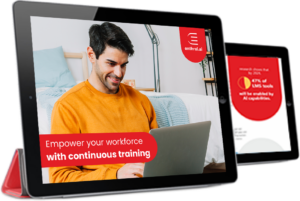Workforce Skilling Strategies for an AI-Powered World

The urgency of addressing skills gap is loud and clear. Studies show that by 2030, the world is likely to face a shortage of over 85 million skilled workers and if not addressed, this talent gap could lead to approximately $8.5 trillion in lost annual revenues.
Since 2015, the skill sets required for jobs have shifted (Source: World Economic Forum) by approximately 25%, and by 2028, it is estimated that 44% of workers’ skills will be disrupted. The rapid advancements in generative AI further complicate the landscape.
Undoubtedly, organizations know that this is concerning and majority are aware of existing or imminent skills gaps. In fact, a Forbes report highlights skills gaps as a major future threat for C-suite executives.
Skilling: A Continuous Necessity
What’s important is that this skills gap awareness is not limited to only senior management; it spans all organizational levels. As many as 64% of L&D professionals (Source: LinkedIn) say skilling and reskilling the current workforce to address these gaps is a priority. Employees too share this concern, with 46% believing their current skills will be obsolete by this year.
In this background, the one key point that emerges is that skilling and reskilling initiatives are a constant necessity. The pace of technological advancement and industry changes means that the skills required for most roles are constantly shifting. It is imperative that employees regularly update their skill sets to remain relevant and competitive.
Continuous learning is essential to help the workforce maintain a competitive edge while also enabling organizations to stay agile and innovative. Investing in skilling is a necessity so that employees can adapt to new challenges and opportunities, driving both personal and organizational growth – a point that 82% of employees and 62% of HR directors agree with (Source: Citrix).
The Economic Value of Skilling
Skilling and reskilling are also key components of effective organizational economics, offering a more cost-efficient alternative to external hiring.
Let’s look at a very interesting and clear economic comparison that Josh Bersin provides on this: recruiting a mid-career software engineer, with a salary between $150,000 and $200,000 per year, can incur costs of $30,000 or more, covering recruitment fees, advertising, and technology. New hires also need to go through onboarding and often have a turnover rate that is two to three times greater than that of internal hires.
In contrast, training and reskilling an existing employee usually costs $20,000 or less, potentially saving up to $116,000 per person over three years. While external hiring might fill a role faster, internal candidates tend to have lower turnover rates, perform better sooner, and often require a lower salary.
Governments worldwide too are increasingly acknowledging the importance of skilling, upskilling and reskilling, with many implementing training mandates for employers. This creates opportunities for training providers to leverage available resources and support employee development on a broader scale.
Challenges in Skilling: Addressing the Gaps
Despite constant efforts by L&D and corporate leaders to find better ways to assess and understand workforce skills, significant challenges remain. Traditional methods like self-assessments and manager reviews have limitations and don’t provide a complete picture of skills as employees evolve. Most current assessments are outdated, irregular, and intrusive, leaving room for new, AI-driven solutions.
Plus, organizations are not typically great at being training institutions. L&D teams often lack the capacity, authority, and resources for meaningful, ongoing learning initiatives beyond basic compliance training. Additionally, demonstrating the impact of training efforts is a hurdle, as L&D often struggles to measure specific business outcomes effectively compared to the clear metrics used by marketers and C-suite leaders.
Besides, the current landscape of workforce development solutions has been largely dominated by core HR functions, creating barriers for smaller players and stifling innovative approaches to skills mapping and development. As a result, there are significant opportunities for new AI-driven solutions that can offer fresh perspectives and methods for addressing skills gaps in the workforce.
Skilling Strategies in the Age of AI
When it comes to skilling, L&D professionals often mistake content consumption for skill building. However, people don’t really build skills simply by reading an article or watching a video.
True skill development requires a comprehensive learning experience that includes opportunities for practice as well as application. It should involve varied aspects like coaching, mentoring, and social learning. Achieving this at scale and speed without a significant investment is challenging, but fortunately, technology is rapidly evolving to make it possible.
So far, technology has mainly focused on identifying skills, and features like skills frameworks, personalized learning, and career pathing are hardly new. But what’s changed now is the incredible potential of AI. Learn-tech providers are enhancing their offerings in ways that weren’t possible until recently, thanks to advancements in scale, speed, and ease of use.
We are also seeing a growing number of solutions that are centered on skills verification and analysis, helping organizations identify future skill needs, then structure, verify, and act on that information.
But despite all the technology available, the problem is that organizations often fail to explain to employees why they should invest their limited time and resources into skilling initiatives. Will it lead to a pay raise, a promotion, or at least a lateral move to keep them relevant and employed? Employees also need clear guidance on which skills to develop. In the absence of this, your learning platform could end up being unused and ineffective.

Below, I suggest a few ways of using AI to enhance skill development
1. Enhancing Skills Assessment:
Implementing automated, real-time skills assessments can lead to genuinely skills-based organizations. There’s great potential in the way AI can transform the way L&D teams create personalized assessments. AI tools analyze content from various sources and generate assessments that accurately measure learners’ knowledge and skills based on their current levels.
2. Innovating Talent Management:
AI-driven FRAC Modeling tools are reshaping how we create job descriptions, define KRAs, and build competency models. By moving beyond traditional hiring practices, these tools enable talent management teams to focus on assessing skills and potential, instead of relying only on experience. This shift also offers new opportunities for optimizing hiring strategies and developing tailored learning paths for employees.
Besides, an increasing number of organizations are also transitioning to a skills taxonomy-based approach in hiring due to its emphasis on unique abilities, moving away from the limitations of job descriptions. A skills taxonomy begins with identifying the essential skills and competencies for a specific position. Traditionally, hiring and talent management focused on a role-centric strategy. In contrast, a skills-based approach separates positions into essential skill requirements and evaluates individuals’ capabilities, aligning skills with immediate or future needs.
3. Enabling Learning in the Flow of Work:
AI-driven tools in Learning Management Systems (LMS) and Learning Experience Platforms (LXP) are transforming how we approach skill development.
By delivering targeted learning resources exactly when learners need them for Just in Time (JIT) Learning, these tools make skill acquisition more effective and timely. Similarly, these tools also facilitate On-the-Job Training (OJT) that integrates online and offline learning directly into everyday work activities, allowing employees to develop skills in real-world contexts. AI chatbots with contextual search too play a crucial role here, offering instant, accurate support to enhance learning in real time.
4. Turning Data into Skills Insights:
Managing fragmented data is a common challenge, but AI-driven analytics offers a powerful solution. By organizing and making data easily searchable, these systems provide actionable insights for managing and developing workforce skills. AI analytics not only streamline data from various sources but also help identify skill gaps, track progress, and make informed decisions to enhance talent development strategies.
Parting Thoughts
As we look ahead, it’s clear that skills will become the main currency of career advancement in an increasingly flexible and dynamic job market.
In this AI-powered world, technology will play a crucial role in shaping workforce skilling strategies. Embracing these advancements will not only help businesses stay competitive but also empower employees to build meaningful careers.











